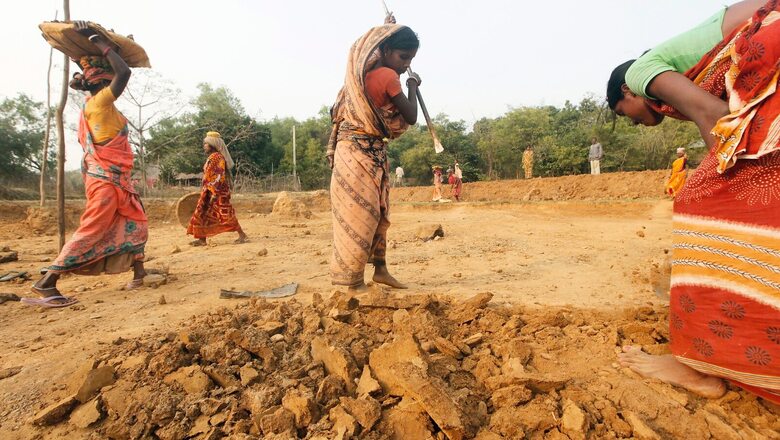
views
The financial year of 2022-23 saw the highest rate of participation in a decade — 56.62% — by women in the formal workforce in rural areas under the Centre’s flagship Mahatma Gandhi National Rural Employment Guarantee Scheme (NREGS). This figure stood at 51.30% in 2012-13, the Lok Sabha was informed on Tuesday.
In a written response to a question, Minister of State for Rural Development Sadhvi Niranjan Jyoti on Tuesday said the rate of participation of women under the Rural Employment Guarantee Scheme has increased over the past 10 years.
As per government data shared by the minister from 2012-13 till February 2 this year, the rise in the number of women workers was much higher in several states — Meghalaya (51.57%), Tripura (48.20%), Jharkhand (47.33%), Karnataka (51.63%), Maharashtra (45%), Uttarakhand (55.95%), Odisha (47.84%), West Bengal (47.94%) and Punjab (66.09%). The figures for these states in the year 2012-13 stood at — 41.07%, 41.08% 32.71%, 46.25%, 44.55%, 46.93%, 35.95%, 33.71% and 46.36%, respectively.
The overall participation of women across states under the scheme was 54.78% in 2021-22, 53.19% in 2020-21, 54.78% in 2019-20, 54.59% in 2018-19, 53.53% in 2017-18, 56.21% in 2016-17, 55.34% in 2015-16, 55.04% in 2014-15, 52.82% in 2013-14 and 51.30% in 2012-13, data showed.
Data also shows that in 2022-23, in states such as Kerala (89.54%), Himachal Pradesh (64.66%), Tamil Nadu (86.01%) and Rajasthan (67.56%), the number of women in the workforce has been quite high, almost outnumbering men.
These states, however, have always had higher percentage of women in the workforce, while there’s a slight downward trend in the figures as compared to 10 years ago. In 2012-13, the figure for Kerala was 92.99%, in Himachal Pradesh it was 60.69%, Tamil Nadu 74.15% and Rajasthan 68.95%.
According to NREGS activists, women in rural areas entered the formal workforce mainly through the scheme, as it guarantees paid work. “The participation has increased over the years with some states such as Rajasthan, Himachal Pradesh, Kerala and Tamil Nadu seeing more women in the workforce than their male counterparts. The year 2022-23 saw a higher average, since after two years of pandemic, many women were displaced from the workforce and found work around this time,” said Nikhil Dey, a NREGS activist.
Dey added that the scheme prevented distress migration and allowed women to stay back and work where they are located. “If not for the scheme, women are still the largest contributors to agriculture operations and labour work at farms, but all of that is unpaid work,” he said.
NREGS is a demand-driven wage employment scheme, which guarantees 100 days of unskilled work per household in rural areas. The demand for work under it had gone up exponentially during the pandemic years. For lakhs of people who had lost their jobs, wages under the scheme were the only source of basic income security.
Read all the Latest India News here




















Comments
0 comment